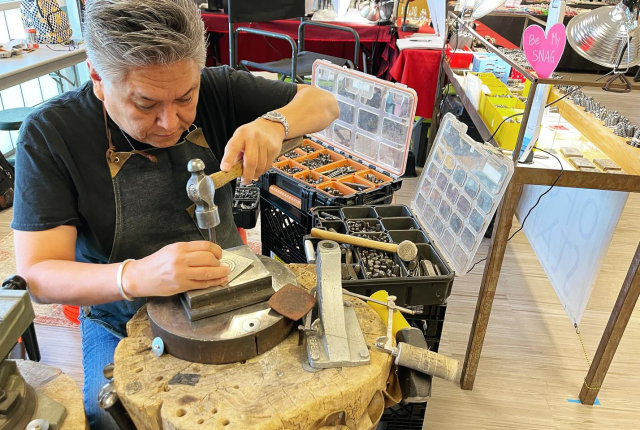LYNDON TSOSIE PARTIED THROUGH his early adulthood and then found his calling in the pages of Dexter Cirillo’s Southwestern Indian Jewelry. The book cost $65, and Tsosie had $75 in his pocket for groceries to feed his young family. “I bought the book and went to the food bank,” he says. “It was the first time I ever invested in myself.” Over the next 30 years, the Diné artist built a career as a silversmith recognized for his asymmetrical shapes, nature-inspired textures, and inlay work. He’s earned top honors at the Santa Fe Indian Market; the Heard Museum Guild Indian Fair and Market, in Phoenix; and the Gallup Inter-Tribal Indian Ceremonial, but the Gallup artist insists he no longer cares about accolades. “Chasing goals just lets me down,” he says. “As soon as I achieve something, I’m right back to the beginning.” Now, he’s striving for better balance, juggling studio work, running his House of Stamps, leading the new Lyndon Foundation, and spending time with his family. “Every time I tell the story of how I got here, I cry,” he says.
When I was 19, I worked at a production house for minimum wage, stamping silver for tourist jewelry.
I was drinking a lot, and my mom wanted me to go to rehab. I went for 29 nights and 30 days. The day I graduated, I went outside and got high.
I opened Southwestern Indian Jewelry to a Charles Loloma bracelet. I had never seen this kind of artistry.
I read the book every day for six months. It was my teacher, my savior.
I left my production mindset behind and started designing.
I went to the Gathering of Nations powwow and just drank for five days. I was supposed to start working for [Navajo jeweler] Teddy Draper, and when I finally got there, he was mad at me.
See? I’m crying.
He gave me a feather to inlay to see how I would do it. And then he talked to me for about five hours about Navajo people. He reminded me as Navajos, we pay homage, we give back in our own way to help us stay on a positive road.
When we were done, everything was different for me.
I had my gallery, in Gallup, and Dexter Cirillo walked in. She’d been down the street interviewing Ray Yazzie for the new edition of the book. I started telling her how she’d saved my life.
She said she’d put me in the new book, and that made all the difference.
I take from everything. Paolo Soleri’s designs, Frank Lloyd Wright’s designs—using those lines, those curves in stones, into a structure where it becomes your own.
I haven’t had a drink in more than 30 years, but I hit rock bottom again recently. I was at the shop 16 hours a day. I wasn’t spending time with my family the way I should, loving them the way I should.
Now I go home at 3 p.m., and I don’t answer the phone.
I’ve won hundreds of awards. After a while, you don’t need those accolades. That’s why I started the Lyndon Foundation.
I thought it was natural to teach young Native Americans how to make jewelry. But it’s more than that. We teach the business—how to set up an LLC, how to create pieces that can be juried, and how to enter shows.
Some people come from families of generational jewelers. You learned to work with silver from your father, who learned it from his father.
I’m a first-generation jeweler. I wanted to be a mentor for others who don’t have families to teach them.
My students are starting to get attention for their work. I feel like I own a fleet of race cars, and they’re all winning.
SEE FOR YOURSELF
Catch Lyndon Tsosie at the Santa Fe Indian Market and learn more about the Lyndon Foundation at thelyndonfoundation.org.


